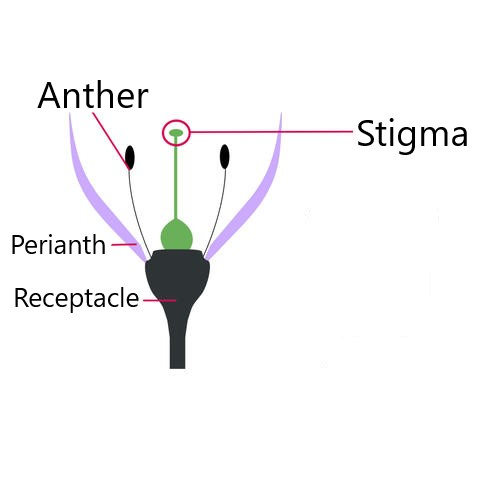
The function of stigma in reproduction is to
(a).Receive Pollen
(b).Receive Anther
(c).Receive Ovum
(d).Receive Carpel
Answer
555.6k+ views
Hint: The stigma is that part of the gynoecium that receives the male gametophyte or microspore. It participates in the process of pollination. The structure received by stigma is also used as tablets and acts as a rich source of nutrition. It has two coverings.
Complete answer:
The main function of stigma in reproduction is to receive the matured pollen grain by the process of pollination either by biotic or abiotic factors. Stigma, style, and ovary together constitute the carpel, which is the unit of gynoecium.
Additional Information:
Stigma can be of the following types:
-Capitate
-Discoid
-Plumose
-Bifid
-Knob like
-Drum shaped
-Dumbbell Shaped
-Dome-shaped
-Sticky
-Linear
-Radiate hood-like.
-Carpels, which are the structural unit of a compound pistillate, may or may not show cohesion. In apocarpous type, the carpels are free, and in syncarpous type, the carpels are fused.
-Based on the number of carpels present on the gynoecium, it can be classified in monocarpellary, bicarpellary, tricarpellary, etc.
The stigma is attached to the style, and the style can be of three main types:
-Gynobasic style is when the style originates from the mid basal part of the ovary. It is seen in Salvia, Ocimum. Gynobasic style is the feature of the Labiatae Family or the mint family. The gynobasic style can be of two types. The style may be inserted laterally at the base of a syncarpous ovary. The style may arise from the center of an apocarpous ovary.
-Terminal style arises from the tip of the ovary.
-Lateral style arises from the side of the ovary.
So, the correct answer is, ‘ receive pollen.’
Note:
The number of lobes in a stigma represents the number of carpels, and according to that, the stigma may be unified, bifid, trifid, trifid, pentafid, or multifid. Several modifications are seen in the shapes of stigma so that they can receive pollen grains. Capitate type of stigma is found in Hibiscus, forked stigma is seen is Tridax, and feathery stigma is seen.

Complete answer:
The main function of stigma in reproduction is to receive the matured pollen grain by the process of pollination either by biotic or abiotic factors. Stigma, style, and ovary together constitute the carpel, which is the unit of gynoecium.
Additional Information:
Stigma can be of the following types:
-Capitate
-Discoid
-Plumose
-Bifid
-Knob like
-Drum shaped
-Dumbbell Shaped
-Dome-shaped
-Sticky
-Linear
-Radiate hood-like.
-Carpels, which are the structural unit of a compound pistillate, may or may not show cohesion. In apocarpous type, the carpels are free, and in syncarpous type, the carpels are fused.
-Based on the number of carpels present on the gynoecium, it can be classified in monocarpellary, bicarpellary, tricarpellary, etc.
The stigma is attached to the style, and the style can be of three main types:
-Gynobasic style is when the style originates from the mid basal part of the ovary. It is seen in Salvia, Ocimum. Gynobasic style is the feature of the Labiatae Family or the mint family. The gynobasic style can be of two types. The style may be inserted laterally at the base of a syncarpous ovary. The style may arise from the center of an apocarpous ovary.
-Terminal style arises from the tip of the ovary.
-Lateral style arises from the side of the ovary.
So, the correct answer is, ‘ receive pollen.’
Note:
The number of lobes in a stigma represents the number of carpels, and according to that, the stigma may be unified, bifid, trifid, trifid, pentafid, or multifid. Several modifications are seen in the shapes of stigma so that they can receive pollen grains. Capitate type of stigma is found in Hibiscus, forked stigma is seen is Tridax, and feathery stigma is seen.

Recently Updated Pages
Master Class 12 English: Engaging Questions & Answers for Success

Master Class 12 Business Studies: Engaging Questions & Answers for Success

Master Class 12 Economics: Engaging Questions & Answers for Success

Master Class 12 Social Science: Engaging Questions & Answers for Success

Master Class 12 Maths: Engaging Questions & Answers for Success

Master Class 12 Chemistry: Engaging Questions & Answers for Success

Trending doubts
Explain sex determination in humans with line diag class 12 biology CBSE

Explain sex determination in humans with the help of class 12 biology CBSE

Differentiate between homogeneous and heterogeneous class 12 chemistry CBSE

Dihybrid cross is made between RRYY yellow round seed class 12 biology CBSE

What is virtual and erect image ?

What is the Full Form of PVC, PET, HDPE, LDPE, PP and PS ?




